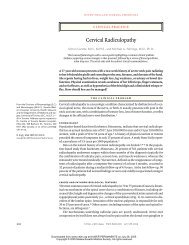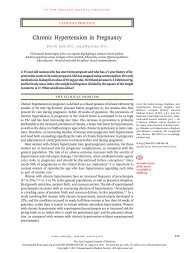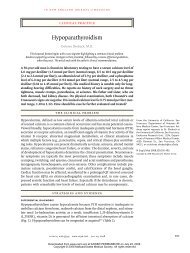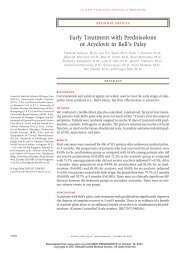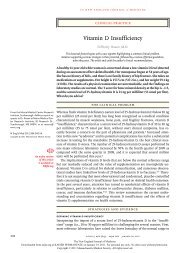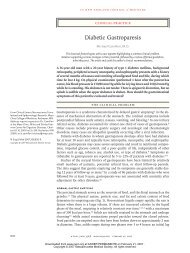Care of Transsexual Persons - Q-Notes for Adult Medicine
Care of Transsexual Persons - Q-Notes for Adult Medicine
Care of Transsexual Persons - Q-Notes for Adult Medicine
Create successful ePaper yourself
Turn your PDF publications into a flip-book with our unique Google optimized e-Paper software.
T h e n e w e ngl a nd j o u r na l o f m e dic i n e<br />
lists the potential side effects <strong>of</strong> sex steroids and<br />
recommendations <strong>for</strong> monitoring.<br />
Risks and Contraindications<br />
A serious concern regarding long-term administration<br />
<strong>of</strong> cross-sex hormones is the possibility <strong>of</strong><br />
an increased risk <strong>of</strong> hormone-dependent cancers.<br />
31 There are rare case reports <strong>of</strong> prolactinomas,<br />
breast cancers, and prostate carcinomas in<br />
male-to-female transsexuals and rare reports <strong>of</strong><br />
ovarian carcinoma, breast cancer, and vaginal<br />
cancer (one each <strong>of</strong> the latter two, to my knowledge)<br />
in female-to-male transsexuals. 31 Rare cases<br />
<strong>of</strong> hormone-dependent tumors in organs other<br />
than the reproductive organs (e.g., lung, colon,<br />
and brain [meningioma]) have also been reported<br />
in transsexuals who have undergone estrogen<br />
treatment. 31 Evidence is lacking to indicate a significantly<br />
increased frequency <strong>of</strong> cancers in association<br />
with cross-sex hormonal treatment, but<br />
the available data are from studies that involved<br />
relatively short-term exposure. Risks may become<br />
more apparent as subjects age and the duration<br />
<strong>of</strong> hormone exposure increases. 31 Because a portion<br />
<strong>of</strong> administered testosterone is aromatized<br />
to estradiol, female-to-male transsexuals who<br />
have not undergone breast removal and oophorectomy–hysterectomy<br />
should be monitored <strong>for</strong><br />
estrogen-sensitive cancers <strong>of</strong> the breast, endometrium,<br />
and ovaries. 31 Although the addition <strong>of</strong> a<br />
progestin may help to prevent endometrial cancer,<br />
studies <strong>of</strong> postmenopausal hormone use<br />
suggest that this therapy may increase the risk <strong>of</strong><br />
breast cancer. 25,32 It has also been reported that<br />
testosterone may contribute to the development<br />
<strong>of</strong> breast 33 and endometrial 34 cancer; there<strong>for</strong>e,<br />
monitoring <strong>of</strong> female-to-male transsexuals <strong>for</strong><br />
such cancers is also prudent. <strong>Transsexual</strong>s may<br />
not always be <strong>for</strong>thright with physicians about<br />
their sex change, and this hesitancy can lead to<br />
delays in diagnosing cancers <strong>of</strong> organs specific<br />
to the <strong>for</strong>mer sex.<br />
Table 2. Recommendations <strong>for</strong> Clinical Assessment and Follow-up during Treatment with Cross-Sex Hormones.<br />
Male-to-female and female-to-male transsexuals<br />
Rule out or treat coexisting conditions; address possible overdose <strong>of</strong> cross-sex hormones, substance abuse, depressive<br />
disorders<br />
Measure bone mineral density and assess <strong>for</strong> osteoporosis at baseline with the use <strong>of</strong> dual energy x-ray absorptiometry<br />
(DEXA), repeating every 1 or 2 yr thereafter if additional risk factors develop or patient stops taking hormones;<br />
determine whether there is a personal or family history <strong>of</strong> osteoporosis (prior fractures); prescribe dosages <strong>of</strong><br />
sex hormones that are adequate to preserve bone mineral density achieved in male-to-female transsexuals with<br />
estrogen administration and in female-to-male transsexuals with aromatization <strong>of</strong> testosterone to estrogen; use<br />
the eugonadal range <strong>of</strong> serum luteinizing hormone as an indicator <strong>of</strong> hormonal dosing adequacy<br />
Determine whether there is a personal or family history <strong>of</strong> cardiovascular disease (combined use <strong>of</strong> estrogens and<br />
antiandrogens may increase serum levels <strong>of</strong> triglycerides, and the use <strong>of</strong> androgens may lower serum levels <strong>of</strong><br />
high-density lipoprotein cholesterol); at follow-up, repeat measurements <strong>of</strong> body-mass index, blood pressure,<br />
and serum levels <strong>of</strong> lipids, fasting glucose, glycated hemoglobin, and liver enzymes; weight gain is typical. The<br />
metabolic syndrome or nonalcoholic fatty liver disease may develop as a result <strong>of</strong> the combination <strong>of</strong> androgen<br />
deprivation and estrogen treatment<br />
Male-to-female transsexuals<br />
Measure serum levels <strong>of</strong> prolactin annually to screen <strong>for</strong> prolactinoma, particularly in patients receiving high-dose<br />
estrogens<br />
Examine breasts to detect any tumors; follow general guidelines <strong>for</strong> breast cancer screening<br />
Examine prostate and consider measurement <strong>of</strong> prostate-specific antigen level in elderly patients, particularly those<br />
with a family history <strong>of</strong> prostate cancer; follow general guidelines <strong>for</strong> prostate cancer screening<br />
Female-to-male transsexuals<br />
Obtain red-cell count to assess <strong>for</strong> erythrocytosis, which is usually related to circulating testosterone levels but can<br />
also be idiosyncratic<br />
Measure serum levels <strong>of</strong> liver enzymes<br />
If there has been no surgical sex reassignment, examine breasts, vagina, ovaries, and uterus <strong>for</strong> cancer<br />
1254<br />
n engl j med 364;13 nejm.org march 31, 2011<br />
The New England Journal <strong>of</strong> <strong>Medicine</strong><br />
Downloaded from nejm.org at KAISER PERMANENTE on March 30, 2011. For personal use only. No other uses without permission.<br />
Copyright © 2011 Massachusetts Medical Society. All rights reserved.






